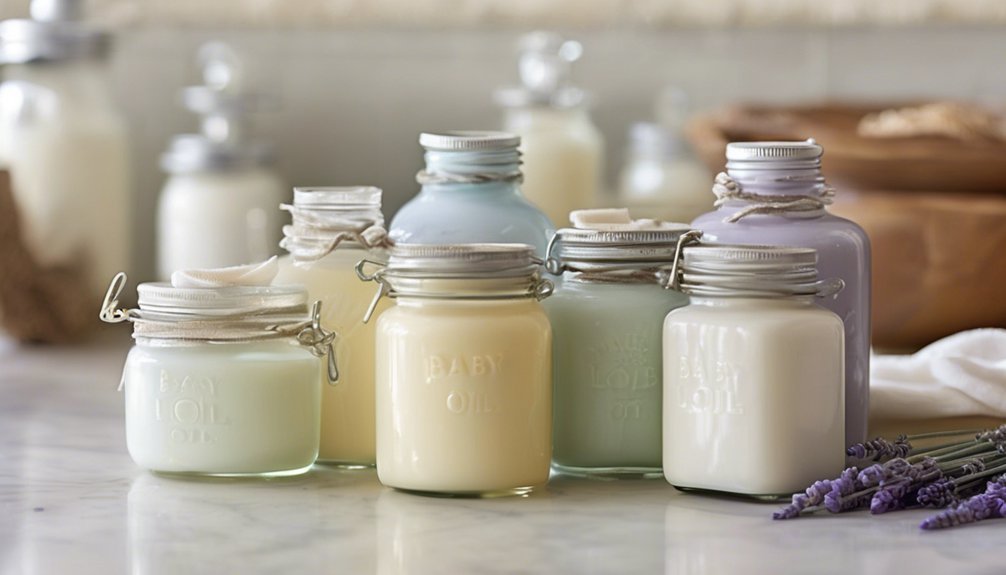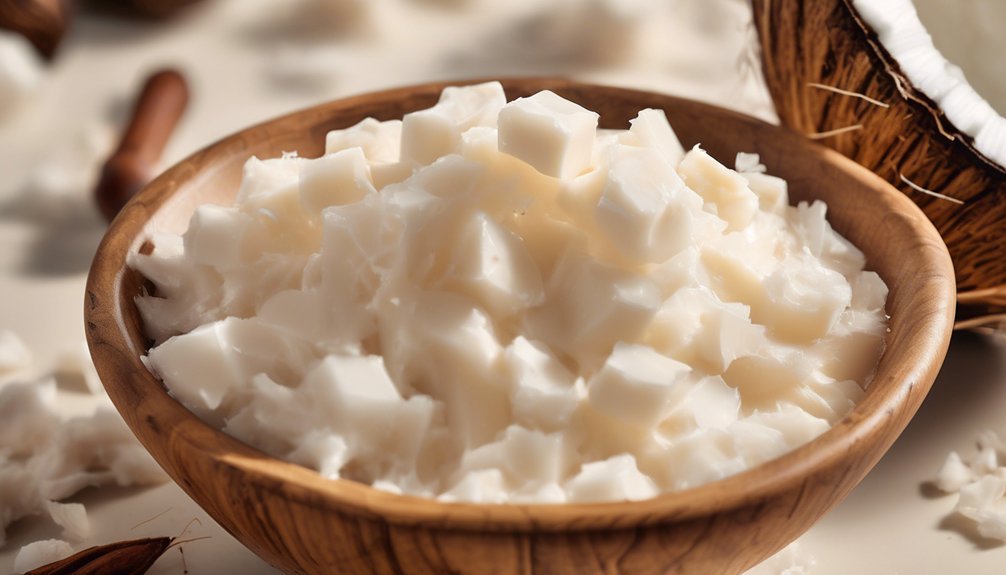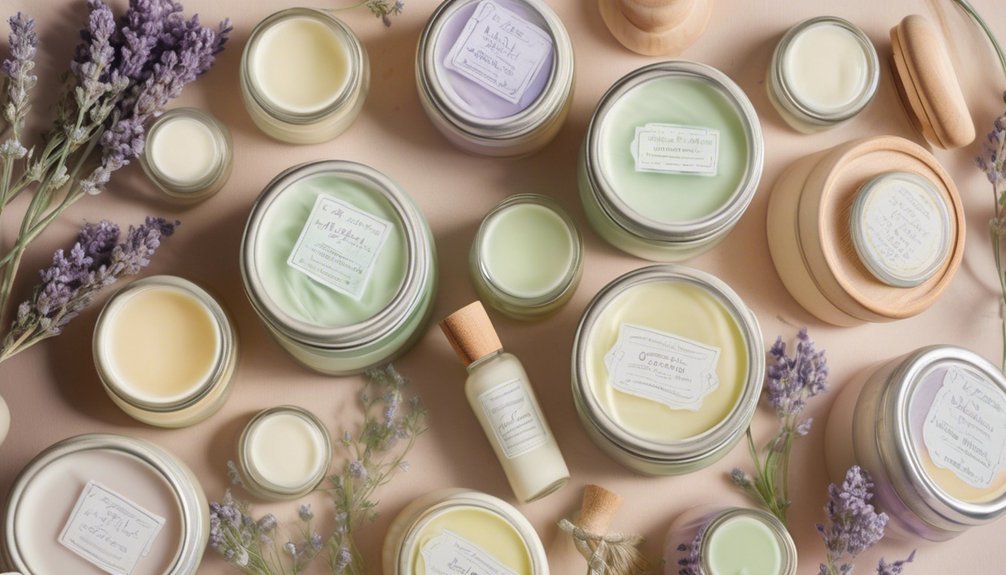Just as a gardener nurtures delicate blooms, you can cultivate your baby’s skin health with simple homemade lotions. These natural blends, crafted from gentle ingredients, not only protect and hydrate but also minimize the risk of irritation. Understanding the specific needs of your baby’s skin is crucial, and there are several effective recipes to explore. Let’s consider how to create these soothing alternatives and ensure your little one’s skin stays healthy and happy.
Key Takeaways
- Use natural ingredients like shea butter and coconut oil to create safe, nourishing baby lotions without synthetic additives.
- Simple recipes include blending coconut oil with shea butter for deep hydration and protection.
- Aloe Vera and olive oil make a soothing lotion that calms irritation and locks in moisture.
- Always perform a patch test for allergies before applying homemade lotion to your baby’s skin.
- Store lotions in clean, airtight containers and label with ingredients and date made for safety.
Understanding Your Baby’s Skin Needs

When you consider your baby’s skin, it’s essential to recognize that it differs significantly from adult skin. Your little one’s skin is more delicate, thinner, and prone to various conditions.
There are different baby skin types, such as dry, oily, and sensitive, each requiring specific care. Common skin issues you might encounter include diaper rashes, eczema, and cradle cap.
Understanding these aspects can help you choose the right products and routines tailored to your baby’s unique needs. Always remember that gentle cleansing and moisturizing are key to maintaining their skin’s health.
Prioritizing your baby’s skin care won’t only soothe irritation but also support their overall comfort and well-being as they grow.
Benefits of Homemade Baby Lotions
Homemade baby lotions offer numerous advantages that align with your baby’s specific skin needs. One of the primary benefits is the use of natural ingredients, which can significantly reduce the risk of irritation.
Commercial products often contain synthetic additives that may not suit your baby’s delicate skin, especially if they’ve skin sensitivity. By choosing homemade options, you can customize the ingredients to avoid allergens and harsh chemicals.
This personal touch not only ensures safety but also allows you to create a soothing and nourishing blend tailored to your baby’s needs. Plus, the act of making the lotion can enhance your bonding experience, making it a nurturing ritual that fosters closeness and care.
Essential Ingredients for Baby Lotion
Choosing the right ingredients is crucial for crafting an effective and safe baby lotion. Start with moisturizing agents like shea butter and coconut oil, which provide deep skin hydration. Incorporate natural preservatives to ensure your lotion stays fresh without harmful chemicals. Essential oils can enhance the scent and offer calming properties, but always consider allergy considerations when selecting them. Additionally, think about texture variations; a lighter lotion might be more suitable for warmer months, while a thicker formula can protect against winter dryness. Below is a quick reference table to help you choose the best ingredients:
| Ingredient | Benefits |
|---|---|
| Shea Butter | Deep hydration |
| Coconut Oil | Nourishing, anti-inflammatory |
| Natural Preservatives | Safety and shelf-life |
| Essential Oils | Calming scents |
| Texture Variations | Customizable feel |
Coconut Oil and Shea Butter Lotion

Coconut oil and shea butter together create a powerful lotion that deeply nourishes and hydrates your baby’s delicate skin.
This combination not only feels luxurious but also offers numerous benefits.
- Coconut benefits: Rich in fatty acids, it provides moisture and protects against dryness.
- Shea properties: Known for its anti-inflammatory properties, it soothes irritation and promotes healing.
- Natural nourishment: Both ingredients are packed with vitamins A and E, essential for skin health.
- Gentle on skin: Free from harsh chemicals, this lotion is perfect for even the most sensitive skin.
Aloe Vera and Olive Oil Lotion
While many parents seek gentle and effective solutions for their baby’s skin, an Aloe Vera and Olive Oil lotion can be an excellent choice.
Aloe Vera is renowned for its soothing and hydrating benefits, perfect for delicate skin. Its anti-inflammatory properties can help calm irritation and redness, making it ideal for babies with sensitive skin.
Olive oil, rich in antioxidants and essential fatty acids, complements aloe by providing deep moisture and nourishment. Together, these ingredients work synergistically to create a protective barrier, locking in hydration while allowing the skin to breathe.
By using this homemade lotion, you’re giving your baby’s skin the gentle care it deserves, ensuring it stays soft, smooth, and healthy.
It’s a simple yet powerful blend for your little one.
Oatmeal and Honey Moisturizer
When you’re looking for a natural way to moisturize your baby’s sensitive skin, an oatmeal and honey moisturizer can be a fantastic option. Oatmeal offers numerous benefits, including soothing irritation and providing a protective barrier.
Honey, with its natural antibacterial properties, helps to lock in moisture while promoting healing.
Here’s how to create this gentle blend:
- Combine finely ground oatmeal with warm water to form a paste.
- Add a tablespoon of raw honey, ensuring it’s well mixed.
- Apply the mixture to your baby’s skin, focusing on dry areas.
- Rinse gently with warm water after 10-15 minutes.
This simple, nourishing moisturizer not only hydrates but also supports your baby’s delicate skin, ensuring it stays soft and healthy.
Calendula Infused Lotion

If you’re seeking a soothing solution for your baby’s skin, a calendula-infused lotion can be an excellent choice. Known for its remarkable calendula properties, this lotion harnesses the power of calendula flowers to provide gentle, skin-soothing relief.
The natural anti-inflammatory and antimicrobial qualities of calendula make it ideal for calming irritated skin, reducing redness, and promoting healing. To create your own, steep dried calendula flowers in a carrier oil, then blend with shea butter and beeswax for a creamy texture.
This nourishing lotion not only hydrates but also protects your baby’s delicate skin. With regular use, you’ll notice a significant improvement in skin softness and overall comfort. Embrace the natural benefits of calendula for your little one’s skincare routine.
Lavender and Chamomile Baby Lotion
Lavender and chamomile baby lotion combines the calming properties of these two gentle botanicals to create a soothing experience for your baby’s sensitive skin.
Lavender properties are well-known for their ability to relax and promote sleep, making it ideal for evening routines. Chamomile benefits include its anti-inflammatory and soothing qualities, which can help reduce redness and irritation.
When you use this lotion, you’ll appreciate:
- A delicate scent that calms both you and your baby.
- Moisturizing ingredients that nourish and protect delicate skin.
- Natural anti-inflammatory effects that soothe discomfort.
- A gentle formula that’s perfect for daily use.
This blend not only cares for your baby’s skin but also enhances your bonding moments with its soothing aroma.
How to Customize Your Lotion
Customizing your homemade baby lotion allows you to tailor the formula to meet your baby’s unique skin needs and preferences.
Start by selecting natural oils and butters that suit your child’s skin type; for dry skin, consider adding shea butter or coconut oil. If your baby has skin allergies, always choose hypoallergenic ingredients to minimize irritation.
You can also create custom scents using essential oils like lavender or chamomile, but be cautious—some oils may not be suitable for sensitive skin. Test any new ingredients on a small area first to ensure there’s no adverse reaction.
Tips for Storing Homemade Lotions

Storing homemade lotions properly is crucial for maintaining their effectiveness and safety. Here are some storing tips to ensure your creations stay fresh and beneficial for your little one:
- Use dark glass containers: They protect against light, which can degrade ingredients.
- Keep them in a cool, dry place: Avoid heat and humidity to extend shelf life.
- Label your containers: Include the date made and ingredients used to track freshness.
- Consider refrigeration for longer storage: This can help preserve natural ingredients.
Safety Precautions When Making Baby Lotion
When making homemade baby lotion, it’s essential to prioritize safety to ensure that your product is both effective and gentle for your little one’s sensitive skin. Start by selecting high-quality, natural ingredients. Conduct allergy testing on a small area of your baby’s skin to check for adverse reactions before applying the lotion more broadly. Keep your workspace clean and sanitized to prevent contamination.
Here’s a quick reference table for ingredient safety:
| Ingredient | Safety Rating | Common Allergens |
|---|---|---|
| Coconut Oil | Safe | Rare |
| Shea Butter | Safe | Rare |
| Essential Oils | Moderate | Common |
| Beeswax | Safe | Rare |
Always consult a pediatrician if you’re uncertain about specific ingredients to maintain your baby’s skin health.
Transitioning to Natural Skincare for Babies
As you explore homemade baby lotions, consider shifting toward natural skincare options for your little one.
Using natural ingredients can be beneficial, especially if your baby has skin sensitivities. Transitioning to these products helps ensure you’re making safe choices for their delicate skin.
Here are some natural ingredients to consider:
- Coconut oil: Moisturizes and soothes dry skin.
- Shea butter: Provides a rich, nourishing barrier against irritants.
- Aloe vera: Calms inflammation and hydrates.
- Calendula oil: Known for its healing properties, perfect for rashes.
Frequently Asked Questions
Can I Use Homemade Lotion on Newborns?
You should always prioritize newborn skin’s sensitivity. Homemade lotions can contain ingredients that aren’t safe. It’s best to consult with a pediatrician to ensure lotion safety before applying anything to your baby’s delicate skin.
How Long Do Homemade Lotions Last?
Homemade lotions typically have a shelf life of one to three months. To extend freshness, store them in a cool, dark place and use clean utensils to avoid contamination. Always check for changes before use.
What if My Baby Has Sensitive Skin?
If your baby has sensitive skin, consider using gentle ingredients. Try sensitive skin remedies, and always perform patch testing before applying new products. This way, you can ensure your baby’s comfort and avoid irritation.
Can I Add Essential Oils to Baby Lotion?
You can add essential oils to baby lotion, but prioritize baby safety. Always dilute oils properly and choose gentle varieties like chamomile or lavender. Consult your pediatrician to ensure the oils are suitable for your baby’s sensitive skin.
Are There Any Allergens in Common Lotion Ingredients?
Yes, common allergens in lotion ingredients include fragrances, preservatives, and certain oils. Always check labels for ingredients like parabens or gluten, as they may trigger sensitivities. Your skin deserves the gentlest care possible.
Conclusion
Creating your own baby lotion is like unlocking a treasure chest of softness and care for your little one’s skin! With just a few natural ingredients, you can whip up a concoction that’s more nourishing than a spa day for the tiniest of humans. Imagine their skin glowing brighter than the sun! By embracing homemade lotions, you’re not just moisturizing—you’re crafting a bond that’ll last a lifetime. So, roll up your sleeves and let the magic of natural skincare begin!




